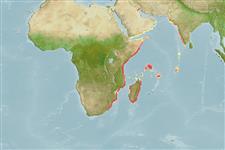>
Gobiesociformes (Clingfishes) >
Gobiesocidae (Clingfishes and singleslits) > Diademichthyinae
Etymology: Lepadichthys: Greek, lepas, -ados = limpet + Greek, ichtys = fish (Ref. 45335).
More on author: Regan.
Environment: milieu / climate zone / depth range / distribution range
Ökologie
seewasser benthopelagisch. Tropical; - 31°S
Western Indian Ocean: Mozambique, South Africa, and Madagascar.
Size / Gewicht / Alter
Maturity: Lm ? range ? - ? cm
Max length : 4.7 cm SL Männchen/unbestimmt; (Ref. 129527)
Kurzbeschreibung
Bestimmungsschlüssel | Morphologie | Morphometrie
Rückenflossenstacheln (insgesamt) : 0; Rückenflossenweichstrahlen (insgesamt) : 11 - 13; Afterflossenstacheln: 0; Afterflossenweichstrahlen: 9 - 11.
Life cycle and mating behavior
Maturities | Fortpflanzung | Spawnings | Egg(s) | Fecundities | Larven
Oviparous, distinct pairing during breeding (Ref. 205).
Fujiwara, K., K. Hagiwara and H. Motomura, 2020. Redescription of Lepadichthys coccinotaenia Regan 1921 and description of Lepadichthys trishula sp. nov. from southern Japan (Gobiesocidae: Diademichthyinae). Ichthyol. Res. 67(3):422-438. (Ref. 129527)
IUCN Rote Liste Status (Ref. 130435)
Bedrohung für Menschen
Harmless
Nutzung durch Menschen
Tools
Zusatzinformationen
Download XML
Internet Quellen
Estimates based on models
Preferred temperature (Ref.
123201): 24.7 - 27.7, mean 26.9 °C (based on 90 cells).
Phylogenetic diversity index (Ref.
82804): PD
50 = 0.5005 [Uniqueness, from 0.5 = low to 2.0 = high].
Bayesian length-weight: a=0.00389 (0.00180 - 0.00842), b=3.12 (2.94 - 3.30), in cm total length, based on all LWR estimates for this body shape (Ref.
93245).
Trophic level (Ref.
69278): 3.6 ±0.1 se; based on diet studies.
Widerstandsfähigkeit (Ref.
120179): mittel, Verdopplung der Population dauert 1,4 - 4,4 Jahre. (Preliminary K or Fecundity.).
Fishing Vulnerability (Ref.
59153): Low vulnerability (10 of 100).
